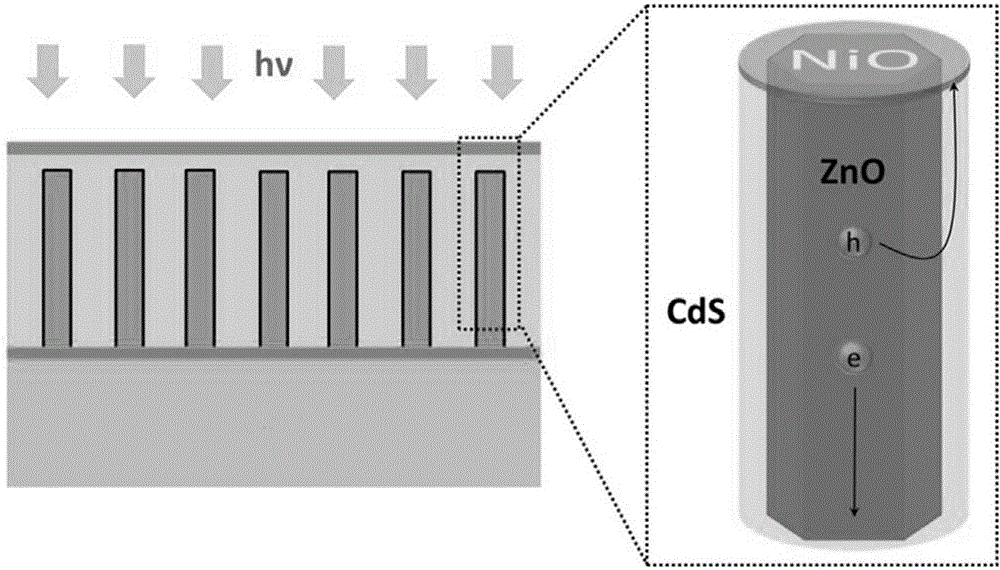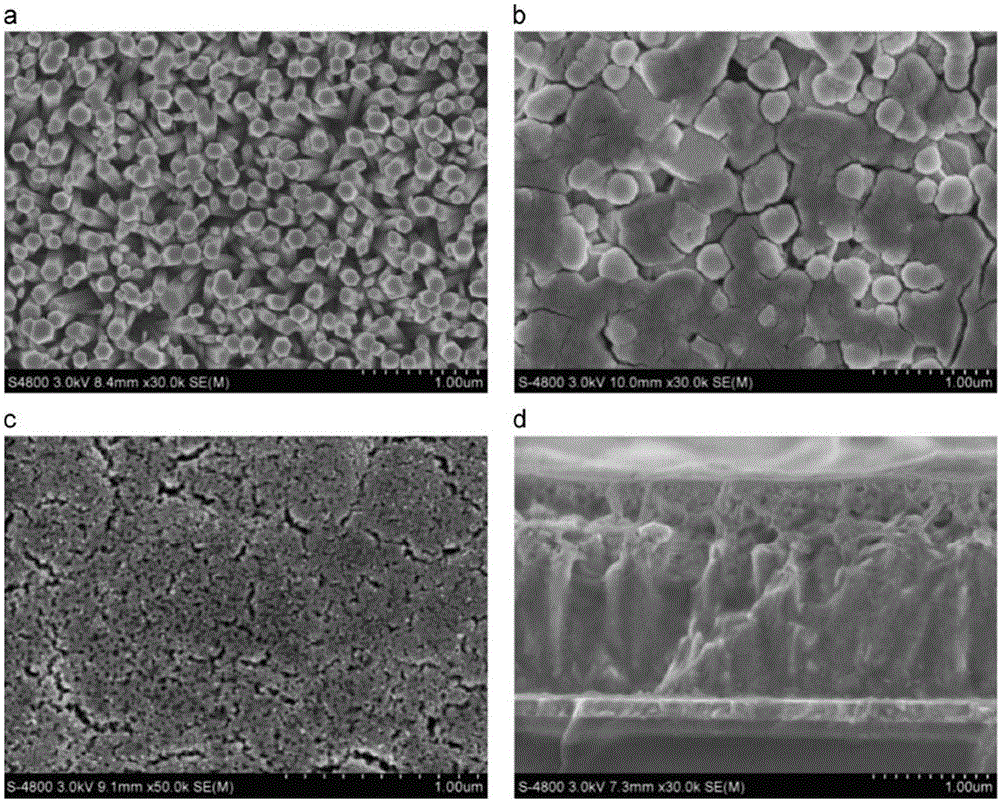ZnO nano-rod photo-anode and preparation method thereof, solar cell
A nanorod and photoanode technology, which is applied in the field of photoelectrodes, can solve the problems of limited use and unsuitability of single-component CdS, and achieve the effects of low cost, improved photoelectrochemical performance, and simple preparation methods
- Summary
- Abstract
- Description
- Claims
- Application Information
AI Technical Summary
Problems solved by technology
Method used
Image
Examples
Embodiment 1
[0037] Follow the steps below to prepare ZnO nanorod photoanodes:
[0038] S1. Growth of ZnO nanorods
[0039] Dissolve zinc acetate in an ethanol solution to make a ZnO seed precursor with a concentration of 20mM, spin-coat the ITO glass substrate at a speed of 2000rpm. for 30s at ambient temperature, and place the ITO glass substrate in a Heat on the heating plate for 5~12min, then hang it upside down in a reaction vessel filled with an aqueous solution of zinc nitrate (75mM) and hexamethylenetetramine (50mM), heat and react at 90°C for 3 hours, then remove from the growth solution , rinsed with ethanol and deionized and then dried to obtain ZnO nanorods.
[0040] Growth of S2, CdS coating layer
[0041] The precursor material of CdS was dissolved in the ethanol solution of cadmium nitrate tetrahydrate (0.5M) and thiourea (0.5M), and spin-coated on the surface of ZnO nanorods at the speed of 2000rpm. Place on a heating plate at 90°C and heat until a thin yellow film is fo...
Embodiment 2
[0050] Follow the steps below to prepare ZnO nanorod photoanodes:
[0051] S1. Growth of ZnO nanorods
[0052] Dissolve zinc acetate in an ethanol solution to make a ZnO seed precursor with a concentration of 15mM. Spin-coat on the ITO glass substrate at a speed of 2000rpm. at ambient temperature for 30s, and place the ITO glass substrate on a heating plate at 180°C Heated above for 12min, then turned upside down and suspended in a reaction vessel filled with an aqueous solution of zinc nitrate (70mM) and hexamethylenetetramine (60mM), heated and reacted at 100°C for 2 hours, removed from the growth solution, and washed with ethanol and After deionized washing and drying, ZnO nanorods were obtained.
[0053] Growth of S2, CdS coating layer
[0054] Dissolve the precursor material of CdS in the ethanol solution of cadmium nitrate tetrahydrate (0.3M) and thiourea (1M), and spin-coat the surface of ZnO nanorods at a speed of 2000rpm. at ambient temperature for 30s, and place th...
Embodiment 3
[0058] Follow the steps below to prepare ZnO nanorod photoanodes:
[0059] S1. Growth of ZnO nanorods
[0060] Dissolve zinc acetate in an ethanol solution to make a ZnO seed precursor with a concentration of 30mM, spin-coat the ITO glass substrate at a speed of 2000rpm. for 30s at ambient temperature, and place the ITO glass substrate on a heating plate at 220°C Heated for 6 minutes, then turned upside down and suspended in a reaction vessel filled with an aqueous solution of zinc nitrate (90mM) and hexamethylenetetramine (80mM), heated at 82°C for 4 hours, removed from the growth solution, and washed with ethanol and After deionized washing and drying, ZnO nanorods were obtained.
[0061] Growth of S2, CdS coating layer
[0062] The precursor material of CdS was dissolved in the ethanol solution of cadmium nitrate tetrahydrate (0.6M) and thiourea (0.3M), and spin-coated on the surface of ZnO nanorods at the speed of 2000rpm. Place on a heating plate at 90°C and heat until...
PUM
 Login to View More
Login to View More Abstract
Description
Claims
Application Information
 Login to View More
Login to View More - R&D
- Intellectual Property
- Life Sciences
- Materials
- Tech Scout
- Unparalleled Data Quality
- Higher Quality Content
- 60% Fewer Hallucinations
Browse by: Latest US Patents, China's latest patents, Technical Efficacy Thesaurus, Application Domain, Technology Topic, Popular Technical Reports.
© 2025 PatSnap. All rights reserved.Legal|Privacy policy|Modern Slavery Act Transparency Statement|Sitemap|About US| Contact US: help@patsnap.com



